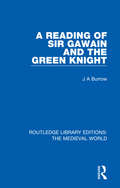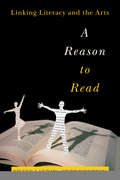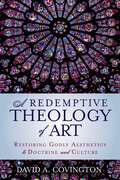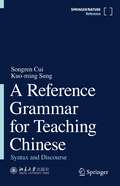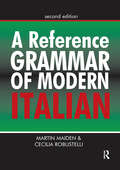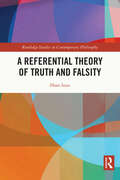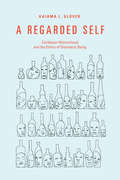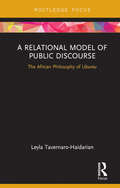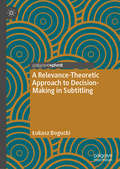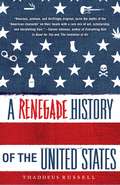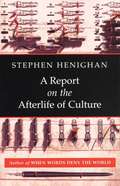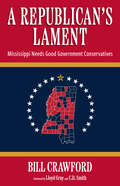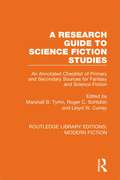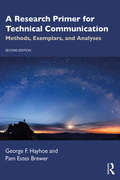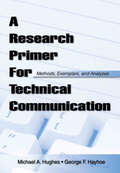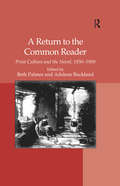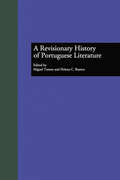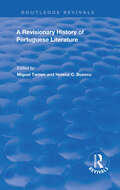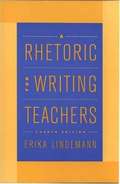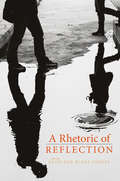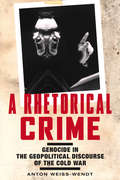- Table View
- List View
A Reading of Sir Gawain and the Green Knight (Routledge Library Editions: The Medieval World #5)
by J A BurrowOriginally published in 1965, A Reading of Sir Gawain and the Green Knight is an interpretation of the most important poem in Middle English literature, the only fourteenth century work which can stand beside Chaucer. The book examines the poem’s conventions and purposes in a critical analysis and provides a useful and insightful introduction to ‘Sir Gawain’. It will be of interest to students and academics studying the poem of Sir Gawain and the Green Knight.
A Real Pal
by Barbara W. MakarDecodable Storybooks 2A accompany More Workbook 2 and provide additional opportunity to apply the phonetic concepts introduced in Workbook 2 to connected text. The storybooks use the same vocabulary as Workbook 2 and Storybooks 2 with the addition of one sight word was. Storybooks 2A are an excellent tool to reinforce the skills from Workbook 2 and can be used with either Workbook 2 or More Workbook 2"--Epsbooks.com.
A Reason to Read: Linking Literacy and the Arts
by Shirley Brice Heath Eileen Landay Kurt WoottonA Reason to Read is the culminating work of the ArtsLiteracy Project, an ambitious and wide-ranging collaborative that aims to promote literacy through rich and sustained instruction in the arts. At the heart of the book is the "Performance Cycle," a flexible framework for curriculum and lesson planning that can be adapted to all content areas and age groups. Each of the book's main chapters delineates and explores a particular component of the cycle. A practical, readable, and inspiring book, A Reason to Read will be of immeasurable help to school teachers, education leaders, and all who have a stake in promoting literacy and the arts in today's schools.
A Reason to Read: Linking Literacy and the Arts
by Eileen Landay Kurt WoottonA Reason to Read is the culminating work of the ArtsLiteracy Project, an ambitious and wide-ranging collaborative that aims to promote literacy through rich and sustained instruction in the arts. At the heart of the book is the &“Performance Cycle,&” a flexible framework for curriculum and lesson planning that can be adapted to all content areas and age groups. Each of the book&’s main chapters delineates and explores a particular component of the cycle. A practical, readable, and inspiring book, A Reason to Read will be of immeasurable help to school teachers, education leaders, and all who have a stake in promoting literacy and the arts in today&’s schools.
A Redemptive Theology of Art: Restoring Godly Aesthetics to Doctrine and Culture
by David A. CovingtonA Redemptive Theology of Art develops a biblical, systematic, and practical theology of aesthetics. It begins with the roots and ontology of aesthetics (vs. "art") and the architecture and narrative of affection and passion, their woes and their glory.Those who would search the Bible find little support for "art" as commonly conceived in the West. The language of aesthetics, applied to the maker’s intentions, the qualities of the work, and the responses of the audience, better addresses the questions of beauty, and better suits the discussion of human actions, beliefs, and culture than the language of art does. The Bible yields more consistent and helpful answers to questions about the broader category of aesthetics than it does to questions about art; leading in turn to better questions and a more practical and theological appreciation of human affections, beauty, and delight, and the many paths by which people, including Christians, pursue them.Using the categories and definitions from Scripture, Covington gives hope and help not only for those who labor in the arts, but for everyone who cares about the passions that motivate us. We were made for God's delight, and, though sin and bondage plague our passions, God can shape our fun, feelings, desires, affections and aversions. Feelings are neither objective nor subjective; they are redeemable. Borrowing key ideas from other Christian writers on the arts or aesthetics, Covington explores the connection between orthodox Protestant theology and a responsible, respectful treatment of arts, artists, and all aesthetic fields of human work and speech.
A Reference Grammar for Teaching Chinese: Syntax and Discourse
by Kuo-ming Sung Songren CuiA Reference Grammar for Teaching Chinese – Syntax and Discourse presents a comprehensive guide on the major issues in teaching Chinese as a foreign language. Through this reference work readers will learn all basic structures of the language, focusing on the interactions of syntactic properties, semantic nuances, and discourse contexts. The work contains ample examples and jargon-free explanations to account for some of the most nagging problems in teaching Chinese. At the heart of this reference resource are the concrete and efficient ways to help researchers in both fields of language pedagogy and Chinese linguistics as well as learners of the language.
A Reference Grammar of Modern Italian (Routledge Reference Grammars)
by Martin Maiden Professor Martin Maiden Dr Cecilia Robustelli Cecilia RobustelliThis Italian reference grammar provides students, teachers and others interested in the Italian language with a comprehensive, accessible and jargon-free guide to the forms and structure of Italian.Whatever their level of knowledge of the language, learners of Italian will find this book indispensable: it gives clear and detailed explanations of everything from the most elementary facts such as the relation between spelling and pronunciation, or the forms of the article, to more advanced points such as the various nuances of the subjunctive. Formal or archaic discourse is distinguished from informal, everyday usage, and regionalisms are also indicated where appropriate. The authors have taken care to make it an easy and illuminating reference tool: extensive cross-referencing enables readers to quickly find the information they require, and also stimulates them to discover new, related facts.
A Referential Theory of Truth and Falsity (Routledge Studies in Contemporary Philosophy)
by Ilhan InanThis book proposes a novel theory of truth and falsity. It argues that truth is a form of reference and falsity is a form of reference failure. Most of the philosophical literature on truth concentrates on certain ontological and epistemic problems. This book focuses instead on language. By utilizing the Fregean idea that sentences are singular referring expressions, the author develops novel connections between the philosophical study of truth and falsity and the huge literature in the philosophy of language on the notion of reference. The first part of the book constructs the author’s theory and argues for it in length. Part II addresses the ways in which the theory relates to and is different from some of the basic theories of truth. Part III takes up how to account for the truth of sentences with logical operators and quantifiers. Finally, Part IV discusses the applications and implications of the theory for longstanding problems in philosophy of language, metaphysics and epistemology. A Referential Theory of Truth and Falsity will appeal to researchers and advanced students working in philosophy of language, epistemology, metaphysics, and linguistics.
A Regarded Self: Caribbean Womanhood and the Ethics of Disorderly Being
by Kaiama L. GloverIn A Regarded Self Kaiama L. Glover champions unruly female protagonists who adamantly refuse the constraints of coercive communities. Reading novels by Marie Chauvet, Maryse Condé, René Depestre, Marlon James, and Jamaica Kincaid, Glover shows how these authors' women characters enact practices of freedom that privilege the self in ways unmediated and unrestricted by group affiliation. The women of these texts offend, disturb, and reorder the world around them. They challenge the primacy of the community over the individual and propose provocative forms of subjecthood. Highlighting the style and the stakes of these women's radical ethics of self-regard, Glover reframes Caribbean literary studies in ways that critique the moral principles, politicized perspectives, and established critical frameworks that so often govern contemporary reading practices. She asks readers and critics of postcolonial literature to question their own gendered expectations and to embrace less constrictive modes of theorization.
A Relational Model of Public Discourse: The African Philosophy of Ubuntu (Routledge Focus on Communication Studies)
by Leyla Tavernaro-HaidarianContemporary democratic discourses are frequently, though not exclusively, characterized by an attitude of ‘pro and con' where the aim is to persuade others, a jury or an audience, of what is right and what is wrong. Challenging such procedures, this book teases out an alternative model of public discourse that is based in collaboration and deliberation. The African philosophy of ubuntu offers valuable insights in this regard as it implies relational notions of power that contrast and complement individualist facets. It provides the space to think and speak in ways that support harmonious and cohesive societal structures and practices. The book’s model of communication rests on the premise that the various interests of individuals and groups, while richly diverse, can be conceived of as profoundly bound-up rather than incompatible. In this way communication enables broader lines of action and a wider scope for achieving diversity and common ground.
A Relevance-Theoretic Approach to Decision-Making in Subtitling
by Łukasz BoguckiThis book aims to investigate the process of decision-making in subtitling of feature films and entertainment series. The author uses Relevance Theory (Sperber and Wilson,1986) to argue that the technical, linguistic and translational constraints at work in subtitling result in a curtailed target text, and illustrates this argument by invoking examples drawn from the English-Polish subtitles of films and television series available through the subscription service Netflix. After introducing the current state of research on audiovisual translation within and outside the framework of translation studies, he presents the core concepts underpinning Relevance Theory and explains how it can be used to construct a model of the process of subtitling. This book will be of interest to students and scholars working in the fields of translation studies, audiovisual translation studies, and communication studies.
A Renegade History of the United States: How Drunks, Delinquents, And Other Outcasts Made America
by Thaddeus RussellIn this groundbreaking book, noted historian Thaddeus Russell tells a new and surprising story about the origins of American freedom. Rather than crediting the standard textbook icons, Russell demonstrates that it was those on the fringes of society whose subversive lifestyles helped legitimize the taboo and made America the land of the free. In vivid portraits of renegades and their “respectable” adversaries, Russell shows that the nation’s history has been driven by clashes between those interested in preserving social order and those more interested in pursuing their own desires—insiders versus outsiders, good citizens versus bad. The more these accidental revolutionaries existed, resisted, and persevered, the more receptive society became to change. Russell brilliantly and vibrantly argues that it was history’s iconoclasts who established many of our most cherished liberties. Russell finds these pioneers of personal freedom in the places that usually go unexamined—saloons and speakeasies, brothels and gambling halls, and even behind the Iron Curtain. He introduces a fascinating array of antiheroes: drunken workers who created the weekend; prostitutes who set the precedent for women’s liberation, including “Diamond Jessie” Hayman, a madam who owned her own land, used her own guns, provided her employees with clothes on the cutting-edge of fashion, and gave food and shelter to the thousands left homeless by the 1906 San Francisco earthquake; there are also the criminals who pioneered racial integration, unassimilated immigrants who gave us birth control, and brazen homosexuals who broke open America’s sexual culture. Among Russell’s most controversial points is his argument that the enemies of the renegade freedoms we now hold dear are the very heroes of our history books— he not only takes on traditional idols like John Adams, Thomas Jefferson, Andrew Carnegie, John Rockefeller, Thomas Edison, Franklin Roosevelt, and John F. Kennedy, but he also shows that some of the most famous and revered abolitionists, progressive activists, and leaders of the feminist, civil rights, and gay rights movements worked to suppress the vibrant energies of working-class women, immigrants, African Americans, and the drag queens who founded Gay Liberation. This is not history that can be found in textbooks— it is a highly original and provocative portrayal of the American past as it has never been written before.
A Report on the Afterlife of Culture
by Stephen HenighanIn this essay collection, Henighan ranges across continents, centuries and linguistic traditions to examine how literary culture and our perception of history are changing as the world grows smaller. He weaves together daring literary criticism with front-line reporting on events such as the end of the Cold War in Poland and African reactions to the G8 Summit.
A Republican's Lament: Mississippi Needs Good Government Conservatives
by Bill CrawfordBill Crawford thought his modern-day Republican Party would lift Mississippi off the bottom, a notion born of Gil Carmichael’s vision for good government conservatism. A Republican’s Lament tells of Crawford’s dedicated efforts to implement Carmichael’s vision, his keen observations of Mississippi’s struggles, and his critical commentaries over the past half century.For more than fifty years, few people have had a better view or a wider variety of roles in the ups and downs of Mississippi and its communities than Crawford. The Canton native has been a daily newspaper reporter, a crusading small-town weekly editor, a Republican Party leader, a reform-minded Republican state representative, an influential Institutions of Higher Learning board trustee, a successful banker, a community college administrator, a state economic development official, a community development leader and nonprofit founder, a mentor of developing community leaders, and a syndicated political columnist. From Gil Carmichael's vision for good government and Haley Barbour’s pragmatic conservatism to starve the beast and truth management politics, poverty and the Cycle of Prosperity, Faulkner’s curse and other behavioral shadows, the Ayers case, and more, Crawford weaves a unique and eventful story about his home state’s enduring dilemmas and a clarion call for its better possibilities.
A Research Guide to Science Fiction Studies: An Annotated Checklist of Primary and Secondary Sources for Fantasy and Science Fiction (Routledge Library Editions: Modern Fiction)
by Marshall B. Tymn, Roger C. Schlobin and Lloyd W. CurreyAcademic attention to science fiction and fantasy began in 1958, when the Modern Language Association scheduled its first seminar on science fiction at its New York meeting. Over the years science fiction emerged as a popular subject that achieved critical attention and acceptance as an academic discipline. A Research Guide to Science Fiction Studies, originally published in 1977, is designed to provide the reader – whether they be scholar, teacher, librarian, or fan – with a comprehensive listing of the important research tools that have been published in the United States and England through 1976. The volume contains over 400 selected, annotated entries covering both general and specialized sources, including general surveys, histories, genre studies, author studies, bibliographies, and indices, which span the entire range of science fiction and fantasy scholarship.
A Research Primer for Technical Communication: Methods, Exemplars, and Analyses
by Pam Estes Brewer George F HayhoeThis fully revised edition provides a practical introduction to research methods for anyone conducting and critically reading technical communication research. The first section discusses the role of research in technical communication and explains in plain language how to conduct and report such research. It covers both quantitative and qualitative methods, as well as surveys, usability studies, and literature reviews. The second section presents a collection of research articles that serve as exemplars of these major types of research projects, each followed by commentary breaking down how it corresponds to the information on that research type. In addition to five new chapters of exemplars and commentaries, this second edition contains a new chapter on usability studies. This book is an essential introduction to research methods for students of technical communication and for industry professionals who need to conduct and engage with research on the job.
A Research Primer for Technical Communication: Methods, Exemplars, and Analyses
by George F. Hayhoe Michael A. HughesThis practical volume provides a thorough introduction to conducting and critically reading research in technical communication, complete with exemplars of research articles for study. Offering a solid grounding in the research underpinnings of the technical communication field, this resource has been developed for use in master’s level and upper-division undergraduate research methods courses in technical and professional communication.
A Return to the Common Reader: Print Culture and the Novel, 1850–1900
by Adelene BucklandIn 1957, Richard Altick's groundbreaking work The English Common Reader transformed the study of book history. Putting readers at the centre of literary culture, Altick anticipated-and helped produce-fifty years of scholarly inquiry into the ways and means by which the Victorians read. Now, A Return to the Common Reader asks what Altick's concept of the 'common reader' actually means in the wake of a half-century of research. Digging deep into unusual and eclectic archives and hitherto-overlooked sources, its authors give new understanding to the masses of newly literate readers who picked up books in the Victorian period. They find readers in prisons, in the barracks, and around the world, and they remind us of the power of those forgotten readers to find forbidden texts, shape new markets, and drive the production of new reading material across a century. Inspired and informed by Altick's seminal work, A Return to the Common Reader is a cutting-edge collection which dramatically reconfigures our understanding of the ordinary Victorian readers whose efforts and choices changed our literary culture forever.
A Revisionary History of Portuguese Literature (Hispanic Issues #18)
by Miguel Tamen Helena C. BuescuFirst published in 1999. Routledge is an imprint of Taylor & Francis, an informa company.
A Revisionary History of Portuguese Literature (Hispanic Issues Ser.)
by Miguel Tamen Helena C. BuescuFirst published in 1999, this volume is a collection of papers on Portuguese literature, giving a historical and more updated review. Included are twelve essays presented in chronological order, providing students with a series of assessments and developments.
A Rhetoric And Handbook
by Richard M. Weaver Richard S. BealThis volume consists of Parts I-IV of Rhetoric and Composition: A Course in Writing and Reading by Richard M. Weaver.
A Rhetoric For Writing Teachers 4th Edition
by Erika C. Lindemann Daniel AndersonFrom answering the question "Why teach writing?" to offering guidance in managing group work and responding to assignments, A Rhetoric for Writing Teachers provides a comprehensive introduction to the teaching of writing. Now in a fourth edition, this remarkably successful book features a new chapter by Daniel Anderson on teaching with computers and adds updated material on invention, intellectual development, and responding to students' writing. Describing in straightforward terms the cross-disciplinary scholarship that underlies composition teaching, it opens with chapters on prewriting techniques, organizing material, paragraphing, sentence structure, words, and revising that show teachers how to lead students through composing. Sections on writing workshops, collaborative learning, and instructional technology reflect current views of writing as a social interaction. Chapters on rhetoric, cognition, and linguistics explain theoretical principles that support classroom practices and make teachers' performances more effective. Treating both the theory and practice of writing, this classic book encourages teachers to adopt the methods that best meet their students' needs and to develop a style of teaching based on informed decisions. It provides an extensive updated bibliography--including useful Web sites as well as important books and articles--and an updated table of important dates in the history of composition. A Rhetoric for Writing Teachers, 4/e, offers both prospective and seasoned writing teachers convenient access to influential scholarship in the field and inspires them to examine what it means to teach well.
A Rhetoric of Reflection
by Kathleen Blake YanceyReflection in writing studies is now entering a third generation. Dating from the 1970s, the first generation of reflection focused on identifying and describing internal cognitive processes assumed to be part of composing. The second generation, operating in both classroom and assessment scenes in the 1990s, developed mechanisms for externalizing reflection, making it visible and thus explicitly available to help writers. Now, a third generation of work in reflection is emerging. As mapped by the contributors to A Rhetoric of Reflection, this iteration of research and practice is taking up new questions in new sites of activity and with new theories. It comprises attention to transfer of writing knowledge and practice, teaching and assessment, portfolios, linguistic and cultural difference, and various media, including print and digital. It conceptualizes conversation as a primary reflective medium, both inside and outside the classroom and for individuals and collectives, and articulates the role that different genres play in hosting reflection. Perhaps most important in the work of this third generation is the identification and increasing appreciation of the epistemic value of reflection, of its ability to help make new meanings, and of its rhetorical power—for both scholars and students. Contributors: Anne Beaufort, Kara Taczak, Liane Robertson, Michael Neal, Heather Ostman, Cathy Leaker, Bruce Horner, Asao B. Inoue, Tyler Richmond, J. Elizabeth Clark, Naomi Silver, Christina Russell McDonald, Pamela Flash, Kevin Roozen, Jeff Sommers, Doug Hesse
A Rhetorical Crime: Genocide in the Geopolitical Discourse of the Cold War (Genocide, Political Violence, Human Rights)
by Anton Weiss-Wendt Douglas Irvin-EricksonThe Genocide Convention was drafted by the United Nations in the late 1940s, as a response to the horrors of the Second World War. But was the Genocide Convention truly effective at achieving its humanitarian aims, or did it merely exacerbate the divisive rhetoric of Cold War geopolitics?A Rhetorical Crime shows how genocide morphed from a legal concept into a political discourse used in propaganda battles between the United States and the Soviet Union. Over the course of the Cold War era, nearly eighty countries were accused of genocide, and yet there were few real-time interventions to stop the atrocities committed by genocidal regimes like the Cambodian Khmer Rouge. Renowned genocide scholar Anton Weiss-Wendt employs a unique comparative approach, analyzing the statements of Soviet and American politicians, historians, and legal scholars in order to deduce why their moral posturing far exceeded their humanitarian action.
